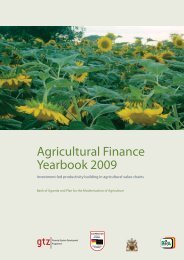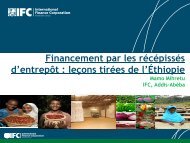Innovations in Rural and Agriculture Finance
Innovations in Rural and Agriculture Finance
Innovations in Rural and Agriculture Finance
Create successful ePaper yourself
Turn your PDF publications into a flip-book with our unique Google optimized e-Paper software.
shocks that could severely depress earn<strong>in</strong>gs performance <strong>and</strong> themore cross-subsidization can occur. High-marg<strong>in</strong> f<strong>in</strong>ancial products—such as consumer f<strong>in</strong>ance <strong>and</strong> urban microf<strong>in</strong>ance—can compensatefor lower profit marg<strong>in</strong> products, such as agricultural loans.Excessive provision<strong>in</strong>g: The last l<strong>in</strong>e of defense is called“loan loss provision<strong>in</strong>g,” mean<strong>in</strong>g an <strong>in</strong>ternal absorption of creditrisk. Adequate provision<strong>in</strong>g accord<strong>in</strong>g to a risk-classificationscheme helps to protect the <strong>in</strong>termediary from liquidity <strong>and</strong> capitaladequacy crises. Some lead<strong>in</strong>g agricultural lenders <strong>in</strong> Lat<strong>in</strong> America,for example, provision from 121 to 260 percent of doubtful loans.Heavy provision<strong>in</strong>g, however, clearly constra<strong>in</strong>s the volume oflend<strong>in</strong>g, ability to make a profit, <strong>and</strong> client outreach potential.Implications for managers of f<strong>in</strong>ancial<strong>in</strong>stitutions <strong>and</strong> public policymakersThere are numerous implications of these credit risk-managementtechniques. First, the credit risk evaluation systems are labor<strong>in</strong>tensive with high costs, which, <strong>in</strong> turn, contribute to high lend<strong>in</strong>g<strong>in</strong>terest rates. Public-sector policymakers need to underst<strong>and</strong> this,so they avoid impos<strong>in</strong>g <strong>in</strong>terest rate ceil<strong>in</strong>gs or forc<strong>in</strong>g publiclyowned banks to charge <strong>in</strong>terest rates that are lower than their trueoperat<strong>in</strong>g costs because results would then be counterproductive.Additionally, fewer <strong>in</strong>termediaries would be will<strong>in</strong>g or able to servethe sector. Therefore, both policymakers <strong>and</strong> managers should focuson develop<strong>in</strong>g <strong>and</strong> implement<strong>in</strong>g <strong>in</strong>stitutional <strong>in</strong>novations—suchas credit bureaus, applications of <strong>in</strong>formation <strong>and</strong> communicationtechnology, <strong>and</strong> delegated agent models of service delivery—thatwill reduce overall operat<strong>in</strong>g costs.Second, agricultural lend<strong>in</strong>g cannot be the primary typeof lend<strong>in</strong>g unless robust risk-transfer techniques (for example,<strong>in</strong>surance, futures, <strong>and</strong> securitization) become more commonplace.In place of l<strong>and</strong>, alternative forms of collateral—<strong>in</strong>clud<strong>in</strong>g warehousereceipts, accounts receivable, equipment, <strong>and</strong> st<strong>and</strong><strong>in</strong>g crops orlivestock—should be more widely accepted. Improved contractenforcement should be aggressively promoted as well. Thesedevelopments would all serve to lower lender risk. Many of these<strong>in</strong>novations <strong>and</strong> <strong>in</strong>stitutional developments require legal <strong>and</strong>regulatory reforms, modernization of property registries, <strong>in</strong>vestments<strong>in</strong> <strong>in</strong>formation <strong>in</strong>frastructure, <strong>and</strong> massive education efforts.Third, the majority of <strong>in</strong>stitutions <strong>in</strong>volved <strong>in</strong> agriculturallend<strong>in</strong>g are small <strong>and</strong> unregulated. They are us<strong>in</strong>g adaptedmicrocredit-lend<strong>in</strong>g technologies that do not fully meet theneeds of farmers, especially those needs regard<strong>in</strong>g loan term <strong>and</strong>repayment frequencies. These shortcom<strong>in</strong>gs pose default risks <strong>in</strong><strong>and</strong> of themselves. The larger <strong>in</strong>stitutions that have the scale <strong>and</strong>scope tend not to enter <strong>in</strong>to agricultural lend<strong>in</strong>g because theydo not have the strategic commitment, proper staff, or branchnetworks. Donors <strong>and</strong> governments can play a vital role <strong>in</strong> assist<strong>in</strong>gthese smaller <strong>in</strong>stitutions to grow, consolidate, <strong>and</strong> eventuallymerge. They can also help rural f<strong>in</strong>ancial <strong>in</strong>termediaries with liabilitydiversification through mobilization of sav<strong>in</strong>gs, access to capitalmarkets, <strong>and</strong> the provision of long-term l<strong>in</strong>es of credit that couldfacilitate more term lend<strong>in</strong>g. Nevertheless, donors <strong>and</strong> governmentsmust price the discount l<strong>in</strong>e of credits <strong>in</strong> a manner that will notunderm<strong>in</strong>e sav<strong>in</strong>gs mobilization.ConclusionIn short, risk management needs to improve dramatically so thatagricultural f<strong>in</strong>ance can flourish. Strides have been made <strong>in</strong> recentyears <strong>in</strong> reduc<strong>in</strong>g <strong>in</strong>formation problems <strong>and</strong> transaction coststhrough, respectively, peer-group lend<strong>in</strong>g <strong>and</strong> a greater reliance on<strong>in</strong>formation <strong>and</strong> communication technology. Uncontrollable risk,however, cont<strong>in</strong>ues to be a major impediment to the developmentof more efficient rural f<strong>in</strong>ancial markets. Renewed private–publicsector efforts <strong>and</strong> higher amounts of <strong>in</strong>vestments will be requiredat various levels to address these issues. At the farmer level,governments need to spur the rebuild<strong>in</strong>g of farm extension services,while farmers need to become more f<strong>in</strong>ancially literate <strong>and</strong> savemore so they can reta<strong>in</strong> some of the risks. Governments, donors,<strong>and</strong> <strong>in</strong>surance companies need to collaborate <strong>in</strong> the developmentof yield-<strong>in</strong>surance products that are <strong>in</strong>expensive, susta<strong>in</strong>able, <strong>and</strong>appropriately designed. Governments, commodity exchanges, <strong>and</strong>f<strong>in</strong>ancial <strong>in</strong>stitutions likewise need to collaborate <strong>in</strong> develop<strong>in</strong>gfutures, structured f<strong>in</strong>ance products, <strong>and</strong> other hedg<strong>in</strong>g <strong>in</strong>strumentsto reduce price risk.At present, the lack of high-quality weather data, <strong>in</strong>adequatedistribution of weather stations, limited supply of people with riskmodel<strong>in</strong>gcapabilities <strong>and</strong> expertise <strong>in</strong> agricultural risk management,small capital markets, <strong>and</strong> weaknesses <strong>in</strong> regulatory <strong>and</strong> legal<strong>in</strong>frastructure hamper the pace of progress. S<strong>in</strong>ce the depth <strong>and</strong>efficiency of f<strong>in</strong>ancial markets are highly correlated with the speedof overall economic development, <strong>in</strong>novative methods of improv<strong>in</strong>grural f<strong>in</strong>ancial services will be critical <strong>in</strong> facilitat<strong>in</strong>g <strong>and</strong> susta<strong>in</strong><strong>in</strong>gany marked improvement <strong>in</strong> rural welfare. nFor further read<strong>in</strong>g: H. Bhattacharya, Bank<strong>in</strong>g Strategy,Credit Appraisal <strong>and</strong> Lend<strong>in</strong>g Decisions: A Risk-Return Framework,(New Delhi, India: Oxford University Press, 1996); J.B. Caoutte, E. I. Altman, <strong>and</strong> P. Narayanan. Manag<strong>in</strong>g CreditRisk: The Next Great F<strong>in</strong>ancial Challenge, (New York: JohnWiley <strong>and</strong> Sons, Inc., 1998); C. Trivelli, <strong>and</strong> A. Tarazona,Riesgo y Portafolios Agropecuarios: Lecciones desde la Experienciade Instituciones F<strong>in</strong>ancieras de América Lat<strong>in</strong>a, Documentode Trabajo 151 (Lima, Perú: Instituto de EstudiosPeruanos, 2007), www.iep.org.pe/textos/DDT/DDT151.pdf;M. Wenner, S. Navajas, C. Trivelli, <strong>and</strong> A. Tarazona, Manag<strong>in</strong>gCredit Risk <strong>in</strong> <strong>Rural</strong> F<strong>in</strong>ancial Institutions <strong>in</strong> Lat<strong>in</strong> America,Susta<strong>in</strong>able Development Department Best Practices SeriesMSM 139 (Wash<strong>in</strong>gton, D.C.: Inter-American DevelopmentBank, 2007); World Bank, Do<strong>in</strong>g Bus<strong>in</strong>ess database, www.do<strong>in</strong>gbus<strong>in</strong>ess.org/economyrank<strong>in</strong>gs.Mark D. Wenner (markw@iadb.org) is a lead f<strong>in</strong>ancial specialist <strong>in</strong> the Capital Markets <strong>and</strong> F<strong>in</strong>ancial Institutions Division of the Inter-AmericanDevelopment Bank.International Food PolicyResearch InstituteSupported susta<strong>in</strong>able solutions by the for CGIAR end<strong>in</strong>g hunger <strong>and</strong> povertywww.ifpri.orgSupported by the CGIARwww.worldbank.orgCopyright © 2010 International Food Policy Research Institute <strong>and</strong> the World Bank. All rights reserved. Contact ifpri-copyright@cgiar.org or pubrights@worldbank.org for permission to republish.







